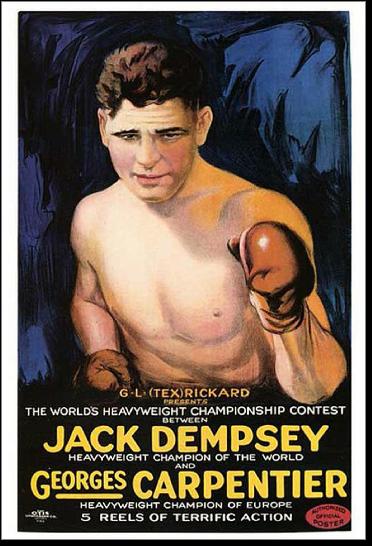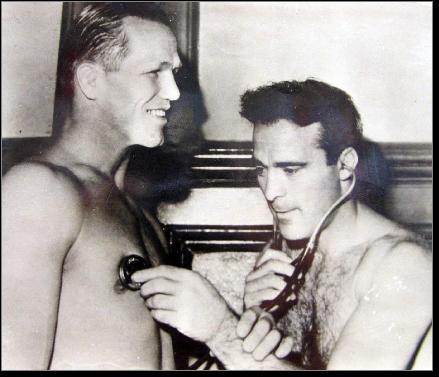|
Great Moments: Boxing
 Frank Hague & The Million Dollar Fight Frank Hague & The Million Dollar Fight
Boxing first million-dollar bout took place in the Garden State. On July 2, 1921, world heavyweight champion Jack Dempsey met light heavyweight title-holder Georges Carpentier, who also held the European heavyweight crown. Promoter Tex Rickard had initially intended to hold the fight in the Polo Grounds, but New York Governor Nathan Miller was not a fan of prizefighting and blocked the plan.
Enter Jersey City Mayor Frank Hague, a notorious powerbroker who never missed a chance to bring business to his town (or line his pockets). Hague purchased a vacant lot from John Boyle, a paper manufacturer, on Montgomery Avenue. The site—which would come to be known as Boyle’s 30 Acres (it was actually 34)—had once been home to the minor-league Jersey City Skeeters. A $250,000 stadium was designed with seating for 50,000 fans. Nearly 1,000 workers built the stadium over the course of 9 weeks. During construction, it was expanded to hold 80,000-plus as interest in the fight increased. Technically an amphitheater, Boyle’s 30 Acres had the greatest seating capacity of any structure of its kind, before or since.
Dempsey, who had successfully his title twice, was one of the most talked-about athletes in the sports world. He was a relentless attacker who was willing to trade blows in order to lure opponents into his deadly punching zone. Carpentier, a French fighter, combined speed, skill and good punching power. He had taken his title from Battling Levinsky earlier that year in Jersey City, at Westside Park. Carpentier was the underdog in the fight, but the fan favorite thanks to his personal charm, good looks and flawless ring technique. The sporting press made the most of another contrast: Dempsey avoided service in World War I, while Carpentier had served in the French Army.
Commercial radio was in its infancy in 1921, with just a handful of stations broadcast in New Jersey and New York. RCA was keen on doing live coverage of the fight. It set up a huge General Electric transmitter in neighboring Hoboken, from where the call of the fight was carried to theaters and auditoriums across the country. It would be the first world title fight broadcast live on radio.
The gates opened in the afternoon and the stadium was filled by the time local favorite Frankie Burns out-pointed Packey O’Gatty in eight rounds. Among the spectators were hundreds of women, who had traditionally been denied entry to U.S. prize fights. The total gate was reportedly $1.7 million, easily surpassing the previously unreachable $1 million plateau.
The main event saw the champion, who outweighed the challenger by 20 pounds, control a quiet first round. In the second round, Carpentier landed a hard right that some claimed could have knocked out another fighter. As it was, it withered Dempsey and backed him to the ropes. Had the punch found Dempsey’s famed “iron jaw,” it may well have changed the course of history. Instead, Carpentier’s blow crashed against Dempsey’s cheekbone, straining ligaments in the Frenchman’s wrist and fracturing his thumb. The pain prevented him from following with a combination, as dictated by his usual strategy and style.
Two rounds later, just over a minute into Round 4, Dempsey landed a devastating right hook that sent Carpentier to the canvas for the 10-count.
Zale–Cerdan: 1948 Fight of the Year
When Frenchman Marcel Cerdan climbed into the ring against middleweight champion Tony Zale on September 21, 1948, he was one of the most intriguing fighters in the sport. He had arrived in America two years earlier, with an astounding 93–2 record. Born and raised in France’s Algerian colony, Cerdan fought as a welterweight in North Africa and France in the years before World War II, winning 47 straight fights at one point. He won 23 in a row after that streak was snapped, and then 37 in a row after his next loss.
 During this time, he served with the Allies in the war, and won the Inter-Allied boxing championship. After moving up and capturing the European middleweight crown in July, 1948, Cerdan was given a shot at the world title against Zale. During this time, he served with the Allies in the war, and won the Inter-Allied boxing championship. After moving up and capturing the European middleweight crown in July, 1948, Cerdan was given a shot at the world title against Zale.
Zale was nearing the end of a brilliant career, during which he was middleweight champ twice. He had just taken the belt from longtime nemesis Rocky Graziano 10 weeks earlier with a picture-perfect knockout combination in a bout at Newark’s Ruppert Staduim. Zale was 35, Cerdan 32; both had turned pro 14 years earlier. Each weighed in at a shade under 140 pounds. There had not been a non-American middleweight champ in the 20th century. Zale underestimated his European opponent, predicting to reporters that he would knock out Cerdan in seven rounds. Cerdan was a 2-to-1 underdog. Neither boxer was known for putting on a dull fight. Both were hard punchers, Zale more so than Cerdan, but Cerdan was known for slipping punches against sluggers like Zale.
The championship fight was held in Roosevelt Stadium, in Jersey City. The official attendance was just under 20,000.
Cerdan came out aggressively in the opening rounds, throwing double- and triple-hooks hooks at Zale’s body and head. Zale kept things close with his iron left jab, and clearly won the third and fourth rounds. Both fighters began showing their age as the middle rounds began. Zale seemed to have the upper hand in the 7th, but Cerdan came out hard in the 8th and seized control of the fight. Zale looked like a beaten man in the 10th, and in the 11th Cerdan finished him with a left hook at the end of the round, dropping Zale to his knees. He had to be helped to his corner, where his team let the referee know the fight was over. Their bout was named Fight of the Year by Ring Magazine.
Zale retired after the fight with a lifetime record of 67–18 with a pair of draws. Forty-five of his wins came by knockout. Cerdan’s first title defense came against Jake LaMotta. LaMotta threw Cerdan to the ground in the first round, injuring his shoulder, and went on to win the fight. Before the rematch, Cerdan was killed in a commercial plane crash on his way to New York to see his girlfriend, Edith Piaf, perform a concert.
|
|
|